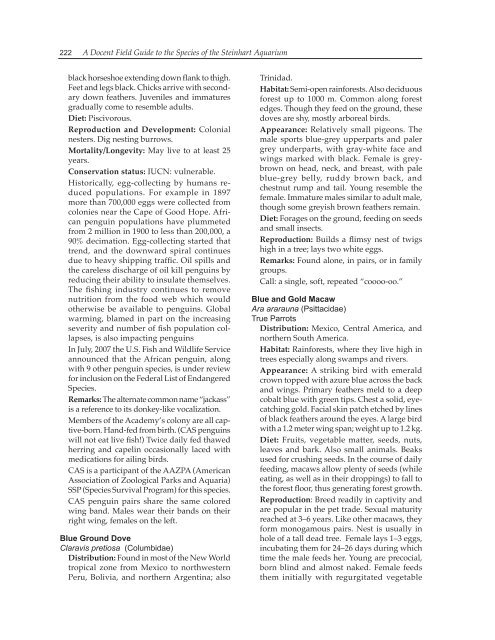THE STEINHART AQUARIUM - Gulf of Guinea Science ...
THE STEINHART AQUARIUM - Gulf of Guinea Science ...
THE STEINHART AQUARIUM - Gulf of Guinea Science ...
Create successful ePaper yourself
Turn your PDF publications into a flip-book with our unique Google optimized e-Paper software.
222 A Docent Field Guide to the Species <strong>of</strong> the Steinhart Aquarium<br />
black horseshoe extending down flank to thigh.<br />
Feet and legs black. Chicks arrive with secondary<br />
down feathers. Juveniles and immatures<br />
gradually come to resemble adults.<br />
Diet: Piscivorous.<br />
Reproduction and Development: Colonial<br />
nesters. Dig nesting burrows.<br />
Mortality/Longevity: May live to at least 25<br />
years.<br />
Conservation status: IUCN: vulnerable.<br />
Historically, egg-collecting by humans reduced<br />
populations. For example in 1897<br />
more than 700,000 eggs were collected from<br />
colonies near the Cape <strong>of</strong> Good Hope. African<br />
penguin populations have plummeted<br />
from 2 million in 1900 to less than 200,000, a<br />
90% decimation. Egg-collecting started that<br />
trend, and the downward spiral continues<br />
due to heavy shipping traffic. Oil spills and<br />
the careless discharge <strong>of</strong> oil kill penguins by<br />
reducing their ability to insulate themselves.<br />
The fishing industry continues to remove<br />
nutrition from the food web which would<br />
otherwise be available to penguins. Global<br />
warming, blamed in part on the increasing<br />
severity and number <strong>of</strong> fish population collapses,<br />
is also impacting penguins<br />
In July, 2007 the U.S. Fish and Wildlife Service<br />
announced that the African penguin, along<br />
with 9 other penguin species, is under review<br />
for inclusion on the Federal List <strong>of</strong> Endangered<br />
Species.<br />
Remarks: The alternate common name “jackass”<br />
is a reference to its donkey-like vocalization.<br />
Members <strong>of</strong> the Academy’s colony are all captive-born.<br />
Hand-fed from birth. (CAS penguins<br />
will not eat live fish!) Twice daily fed thawed<br />
herring and capelin occasionally laced with<br />
medications for ailing birds.<br />
CAS is a participant <strong>of</strong> the AAZPA (American<br />
Association <strong>of</strong> Zoological Parks and Aquaria)<br />
SSP (Species Survival Program) for this species.<br />
CAS penguin pairs share the same colored<br />
wing band. Males wear their bands on their<br />
right wing, females on the left.<br />
Blue Ground Dove<br />
Claravis pretiosa (Columbidae)<br />
Distribution: Found in most <strong>of</strong> the New World<br />
tropical zone from Mexico to northwestern<br />
Peru, Bolivia, and northern Argentina; also<br />
Trinidad.<br />
Habitat: Semi-open rainforests. Also deciduous<br />
forest up to 1000 m. Common along forest<br />
edges. Though they feed on the ground, these<br />
doves are shy, mostly arboreal birds.<br />
Appearance: Relatively small pigeons. The<br />
male sports blue-grey upperparts and paler<br />
grey underparts, with gray-white face and<br />
wings marked with black. Female is greybrown<br />
on head, neck, and breast, with pale<br />
blue-grey belly, ruddy brown back, and<br />
chestnut rump and tail. Young resemble the<br />
female. Immature males similar to adult male,<br />
though some greyish brown feathers remain.<br />
Diet: Forages on the ground, feeding on seeds<br />
and small insects.<br />
Reproduction: Builds a flimsy nest <strong>of</strong> twigs<br />
high in a tree; lays two white eggs.<br />
Remarks: Found alone, in pairs, or in family<br />
groups.<br />
Call: a single, s<strong>of</strong>t, repeated “coooo-oo.”<br />
Blue and Gold Macaw<br />
Ara ararauna (Psittacidae)<br />
True Parrots<br />
Distribution: Mexico, Central America, and<br />
northern South America.<br />
Habitat: Rainforests, where they live high in<br />
trees especially along swamps and rivers.<br />
Appearance: A striking bird with emerald<br />
crown topped with azure blue across the back<br />
and wings. Primary feathers meld to a deep<br />
cobalt blue with green tips. Chest a solid, eyecatching<br />
gold. Facial skin patch etched by lines<br />
<strong>of</strong> black feathers around the eyes. A large bird<br />
with a 1.2 meter wing span; weight up to 1.2 kg.<br />
Diet: Fruits, vegetable matter, seeds, nuts,<br />
leaves and bark. Also small animals. Beaks<br />
used for crushing seeds. In the course <strong>of</strong> daily<br />
feeding, macaws allow plenty <strong>of</strong> seeds (while<br />
eating, as well as in their droppings) to fall to<br />
the forest floor, thus generating forest growth.<br />
Reproduction: Breed readily in captivity and<br />
are popular in the pet trade. Sexual maturity<br />
reached at 3–6 years. Like other macaws, they<br />
form monogamous pairs. Nest is usually in<br />
hole <strong>of</strong> a tall dead tree. Female lays 1–3 eggs,<br />
incubating them for 24–26 days during which<br />
time the male feeds her. Young are precocial,<br />
born blind and almost naked. Female feeds<br />
them initially with regurgitated vegetable


